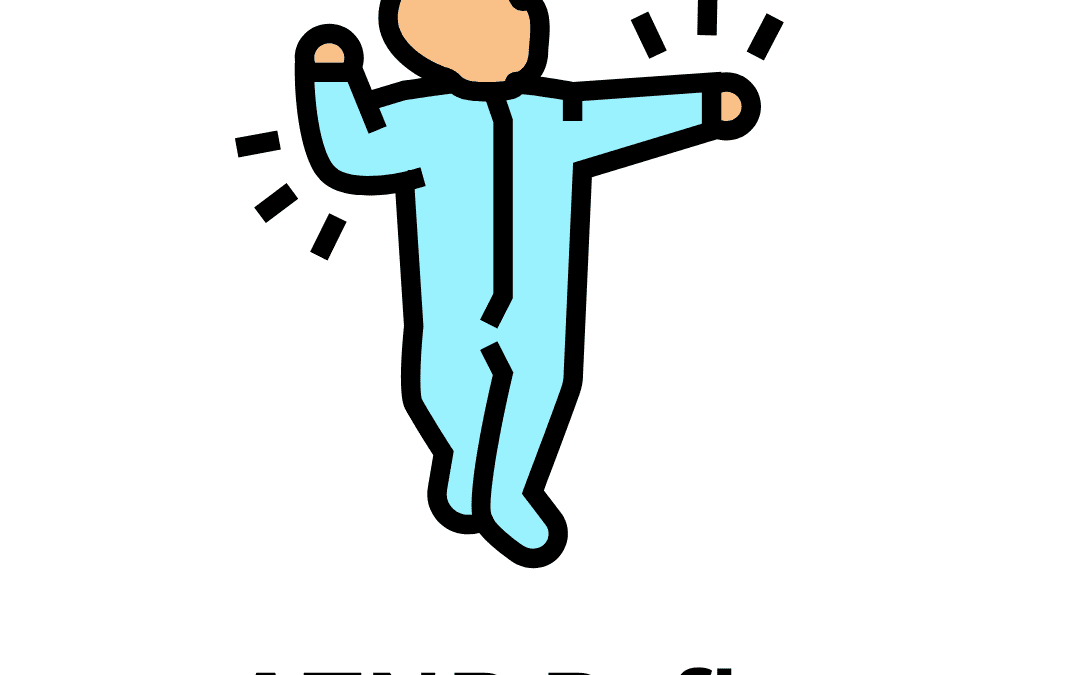
Kids Health, Primitive Reflexes
Understanding the Asymmetrical Tonic Neck Reflex (ATNR)
The human body goes through various developmental stages, particularly during infancy, where primitive reflexes play a crucial role in early movement and neurological development. One such reflex is the Asymmetrical Tonic Neck Reflex (ATNR), an essential component in the early stages of motor development. While it is a normal and expected reflex in newborns, its persistence beyond infancy can lead to developmental challenges.
What is ATNR?
The Asymmetrical Tonic Neck Reflex (ATNR) is a primitive reflex that emerges in utero and is typically present at birth. It is characterized by an automatic movement pattern where passively turning a baby’s head to one side causes the arm and leg on that side to extend while the opposite limbs flex. This reflex is sometimes referred to as the “fencing reflex”because it resembles a fencer’s stance. 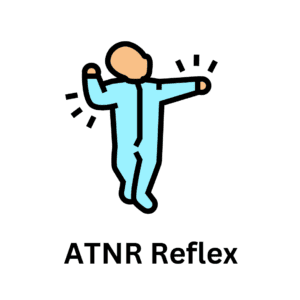
What is the purpose of ATNR?
ATNR serves several critical functions in early development:
– Assists in Birth Process: Helps the baby navigate through the birth canal during delivery.
– Facilitates Hand-Eye Coordination: Encourages visual tracking by linking head movements with arm extension.
– Aids in Early Motor Development: Lays the groundwork for rolling, reaching, finding mid-line, developing dominance and perceptual development
When Should ATNR Integrate?
ATNR is typically active from birth to about 4–6 months of age. As the central nervous system matures, this reflex should gradually integrate between the 6-7th month of age into the whole motor system, allowing for more voluntary and refined motor movements.
What Happens if ATNR Persists?
If ATNR is not properly integrated and remains active beyond six-seven months, it may interfere with development.
Persistent ATNR can contribute to:
– Delayed Motor Development: Difficulty with crawling (cross lateral movements), throwing and catching
– Poor Handwriting and Fine Motor Skills: Struggles with holding a pencil, cutting, or using utensils. Difficulty crossing the midline
– Coordination Issues: Difficulty in bilateral coordination (using both hands together effectively).
– Reading and Learning Challenges: Trouble with left-to-right tracking, affecting reading fluency.
– Attention and focus: Problems maintaining attention, focus, and memory
How to integrate the ATNR
For children (or even adults) with retained ATNR, specific exercises and therapies can help integrate the reflex. These may include:
– Cross-Lateral Movements: Activities like crawling, cross-body marches, climbing walls or bilateral coordination games.
– Neuromodulation Therapy: Guided exercises focusing on reflex integration, active and/or passive
– : Working with therapists to develop motor skills and coordination.
Conclusion
ATNR is a vital reflex for neuromotor development, but if it persists beyond the typical age range, it can create challenges in movement, coordination, and learning. Recognizing and addressing retained ATNR through targeted exercises and therapy can help individuals overcome these difficulties and support their overall development. If you suspect a retained ATNR in your child, consulting a healthcare professional or therapist with specialist training can provide guidance and intervention strategies.
Understanding reflex integration is key to fostering smoother motor development and learning pathways, setting the foundation for a child’s future growth and success.
Lara Cawthra BSc. MChiro. MCSc (Paeds.) FRCC (Paeds.)
Chiropractor and MNRI Core Specialist
Find out more with a Free Advisory Consultation Today >>

Kids Health, Primitive Reflexes
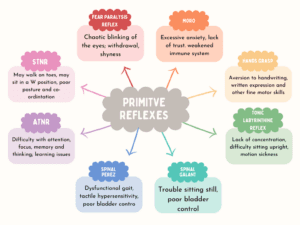
Primitive reflexes are fascinating involuntary movements or actions that are initially present in infants. These reflexes emerge in utero and play an essential role in the early development and survival of newborns. While they may seem like simple bodily reactions, they hold deeper significance in assessing neurological health and developmental milestones. This blog will explore what primitive reflexes are, their types, and their importance in early childhood development.
What Are Primitive Reflexes?
Primitive reflexes are automatic movements triggered by specific stimuli. They originate in the brainstem and are crucial for an infant’s survival and early interaction with the world. These reflexes are typically present at birth and are expected to integrate into the whole body movement system as the child grows and their brain matures. If these reflexes do not integrate by the expected age, it may indicate developmental delays or neurological issues.
Important Primitive Reflexes
Here are some of the primitive reflexes:
Moro Reflex (Startle Reflex): 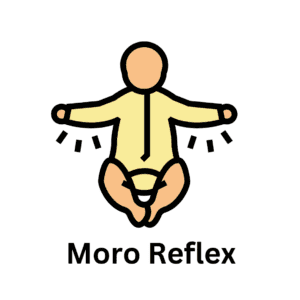
– Trigger: A sudden movement of the infant’s head position.
– Response: The infant spreads their arms (abduction), then brings them back toward their body (adduction), often accompanied by crying on closing of the core.
– Purpose Helps the infant respond to unexpected changes in their environment.
– Integration Age: By 3-4months.
Rooting Reflex: 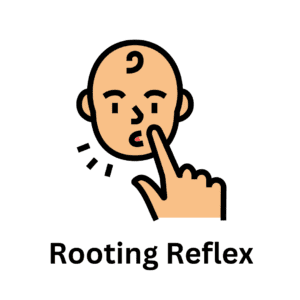
– Trigger: Stroking the infant’s cheek or mouth.
– Response: The infant turns their head toward the stimulus and opens their mouth.
– Purpose: Assists in locating the breast or bottle for feeding.
– Integration Age: By 4 months.
Robinson Hands Grasp Reflex: 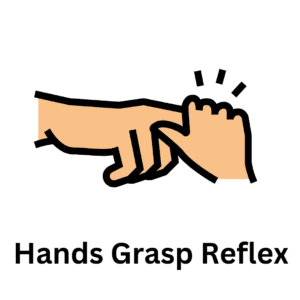
– Trigger: Placing an object or finger in the infant’s palm at the base of the fingers
– Response: The infant grasps the object tightly with the thumb on top of the closed fingers
– Purpose Gross hand-motor coordination, fine motor skills.
– Integration Age: By end of first year of life.
AsymetricTonic Neck Reflex (Fencing posture): 
– Trigger: Reflexive and passive turning of the infant’s head to one side while they are lying on their back.
– Response: The arm and leg on the side the head is turned extends, while the opposite arm and leg bends.
– Purpose: Prepares the body for coordinated movements later in life. Foundation for language development.
– Integration Age: By 6-7 months.
Learn more about the ATNR >>
Why Are Primitive Reflexes Important?
Primitive reflexes serve several purposes during infancy:
- Survival Mechanisms: Reflexes like rooting and sucking ensure that the infant can feed and survive in the early stages of life.
- Neurodevelopmental Health Indicators: The presence, pattern, direction, symmetry, strength, and timing of these reflexes are used by healthcare professionals to assess the integrity of the nervous system and detect potential issues.
- Developmental Foundations: Reflexes pave the way for voluntary movements by building neural connections that contribute to motor skills development.
What Happens When Reflexes Don’t Integrate?
If primitive reflexes persist beyond their typical integration age, it may signal underlying neurological or developmental conditions. For instance:
– Learning Difficulties: Persistent reflexes can interfere with a child’s ability to focus, write, or perform coordinated movements.
– Motor Delays: Reflexes that don’t integrate can hinder the development of fine and gross motor skills.
Early intervention through specific neurodevelopmental exercises can help integrate these reflexes and support the child’s development.
How to Support Reflex Integration
Parents and caregivers can encourage healthy reflex integration through activities and exercises that promote movement and sensory experiences. For example:
– Tummy Time: Helps strengthen neck, shoulder, and core muscles.
– Gentle Stretching and Movement: Encourages flexibility and motor control.
– Interactive Play: Stimulates the senses and fosters coordination.
-Specific exercises and stimulation of neuroreflex points. Work with a certified healthcare provider
Conclusion
Primitive reflexes are more than mere quirks of infancy; they are vital indicators of early brain development and play a foundational role in preparing the body for future learning and growth. Understanding these reflexes can help parents, caregivers, and healthcare professionals ensure that children receive the support they need to thrive. If you have concerns about your child’s reflexes or developmental milestones, consulting a developmental specialist is always a good idea.
Lara Cawthra BSc. MChiro. MCSc (Paeds.) FRCC (Paeds.) Chiropractor and MNRI Core Specialist Find out more with a Free Advisory Consultation Today >>

Spinal Health
Maintaining a healthy spine is essential for overall well-being, mobility, and comfort.
|
To ensure optimal spinal health, try out these practical suggestions:
|

1. Posture
– Stand tall with shoulders back and head aligned with your spine.
– Sit with your feet flat on the floor and knees at a 90-degree angle.
– Use ergonomic furniture to support your natural spinal curves.
2. Exercise & Movement
– Perform core-strengthening exercises to support your back.
– Stretch daily, focusing on hamstrings, hips, and lower back.
– Avoid prolonged sitting; take breaks every 20 minutes to move around.
3. Sleep & Rest
– Sleep on a firm mattress with proper support for your spine.
– Use a pillow that keeps your neck aligned with the rest of your body.
– Avoid sleeping on your stomach, as it strains the neck and back.
4. Lifting & Carrying
– Lift with your legs, not your back—bend your knees and keep the item close to your body.
– Avoid twisting while lifting heavy objects.
– Distribute weight evenly if carrying bags or backpacks.
5. Nutrition & Hydration
– Maintain a healthy weight to reduce strain on your spine.
– Consume a diet rich in calcium and vitamin D for strong bones.
– Stay hydrated to keep spinal discs healthy and lubricated.
6. Avoid Spinal Stress
– Limit wearing high heels or shoes without adequate support.
– Avoid repetitive movements that strain your spine, such as heavy bending or twisting.
– Adjust your workspace to minimize hunching or awkward angles.
7. Regular Chiropractic Checkups
– Get professional assessments to identify and address spinal misalignments.
– Prevent long-term issues with regular maintenance and adjustments.
|
|
|
| |
- Use the checklist to self check your spinal health
- Use the checklist to check someone else
|
|
|
|









Recent Comments